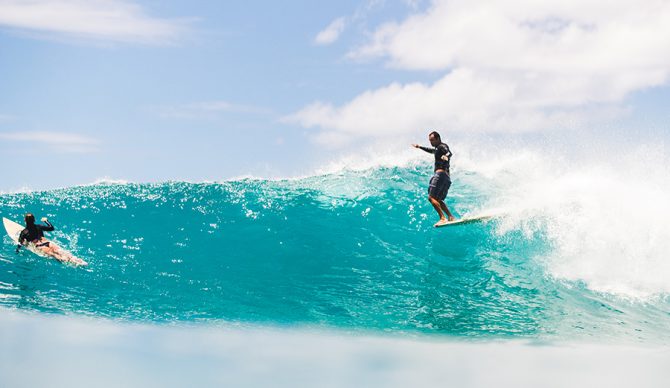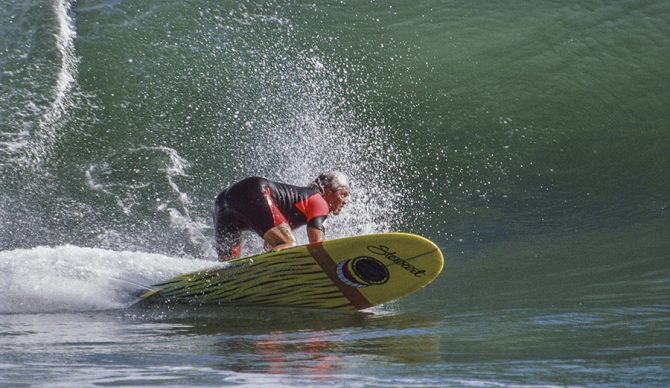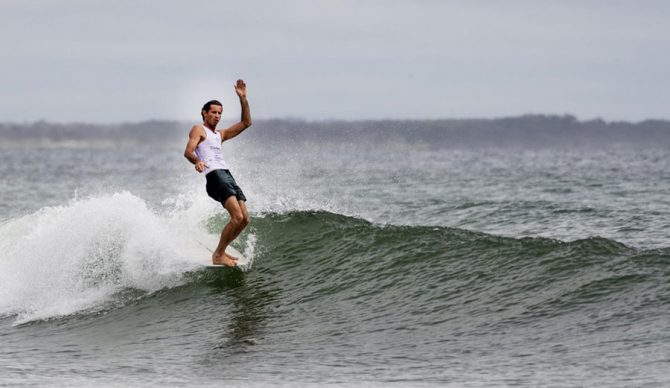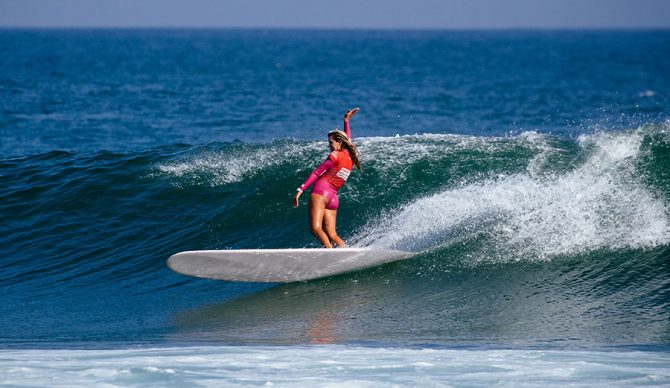
Modern approach, timeless tip-time. Kai Sallas, Queens Surf. photo: Michael Ito
Editor’s Note: Welcome to our new series, “By Design” with Sam George that examines the genius, and sometimes the mystery, of surfing’s storied design history. Sam has been writing about surfing for more than three decades and is the former Editor-in-Chief of SURFER magazine. He won an Emmy for his work on the 30 for 30 documentary, Hawaiian: The Legend of Eddie Aikau. Today, Sam looks at the modern longboard and its varied iterations.
There are plenty of surfers out there who look at a “longboard” and see just that: a long board. These same surfers most probably characterize anyone riding one of those boards simply as a “longboarder.” Truth is, there are two very distinctly different styles of longboard, each with its own rigidly adhered-to design elements, prerequisite application and associative aesthetic: log and high performance. To better explain the difference between the two styles, as well as to present what could be seen as a diplomatic third option, I’ve enlisted an eminently qualified surfer/designer from the longboarding hotbed of Waikiki: 2018 ISA World Longboard Champion Kai Sallas.
Kai, 41, has proven himself adept at every aspect of longboard surfing, having won contests in everything from two-foot Taiwanese windswell to Puerto Escondido barrels, and most recently has launched a eponymous surfboard line, offering designs that reflect plenty of time spent riding both on the tail and the nose.
“The difference between longboard designs really starts with how you want to surf,” says Sallas. “Back in the 1990s everyone was riding high-performance designs that showed the shortboard influence, surfing faster, with sharper turns, roundhouse cutbacks and floaters. Pretty much tail surfing, with minimum noseriding. So the typical board would be a lightweight nine-footer, with a thruster or two-plus-one fin set up, slight concave under the nose, plenty of tail rocker and a down rail with a tucked-under edge.”

1960s star David Nuuhiwa, gone full high performance, circa 1989. photo: Tom Servais.
The board Sallas describes as design of choice in the early 1990s was actually nothing new. The sport’s first longboard era spanned the years 1960 to late 1967, a decidedly short epoch compared to what I’ll call the “second longboard era.” Right around 1975 a number of notable surfer/designers, all of whom were flag-waving foot soldiers during the late-sixties “shortboard revolution,” began revisiting the longboard designs they so enthusiastically forsook only a few years earlier. Three of the most influential were Hawaii’s Ben Aipa, Californian Herbie Fletcher and Floridian-turned-West Coast transplant Bill Stewart – all began applying what they’d learned shaping lightweight, highly maneuverable short boards to those in the nine-foot range. Aside from significantly extending the surf life of myriad older surfers [read: 30 years-plus] over the decades they also became popular with a new generation of younger performers like Sallas, who began to rip, tear, and lacerate, and even ride the barrel, on nine-foot boards.
“Probably the biggest difference between the high performance and the traditional longboard is the rail contour,” says Sallas. “With a tucked-under rail the apex of the curve is actually on the bottom of the board, creating an edge. This causes water wrapping up around the rail to release, which allows you to turn quicker and faster. Then the side fins give you that little extra bite and control.”

Joel Tudor, same as it ever was. Photo: Thomas Bennett//WSL
Those open-minded shapers apparently got it right the first time: high performance longboards, certainly one of, if not the most popular surfboard designs in use today, have seen very little modification since those early years. What has changed, however, is the longboarding aesthetic, which over the past few decades has taken a drop-knee turn into the past. This retro movement traces its roots back to 1994, when the preternaturally talented Joel Tudor, widely considered the world’s best longboarder at the time, began championing a return to what he considered the essence of style on the longer craft: graceful trim, cross-stepping, long noserides and, most importantly, a playful sense of fun. Not hard to see why this approach caught on among the generation that came up under Tudor. Knee-paddling out into lineups today is a new breed of surfer, both male and female, who’ve eschewed riding a nine-foot board as much like a six-foot board as possible, instead choosing to ride refined versions of traditional longboards in traditional style, even embracing the once-derisive moniker of “log.”
View this post on Instagram
“I came late to riding logs,” admits Sallas. “I mean, I dabbled in them at Waikiki over the years, but it wasn’t until around 2018 that I really got into it.”
The ‘logs’ Sallas refers to are typically in the 9’6” to 10’0” range, with outline dimensions that at first glance don’t look much different than their shorter, lighter brethren. Naturally, the difference is in the details.
“A log will generally be a heavier single-fin, with a bit wider nose and tail, slightly rolled bottom, flatter rocker and a 50/50 rail,” explains Sallas. “The flatter rocker gives it the glide and the weight gives stability. The 50/50 rail – meaning that the curve’s apex is at the middle of the rail – causes water to wrap up around the board’s edge and not release. This lets the board lock into trim, especially when you’re moving out of the pocket and onto the open face. So while on a high performance board you get the speed to maneuver by turning off the tail, on a log you’re trimming from the middle of the board, stepping back to turn, then walking forward again.”

Soleil Errico, totally involved at Malibu en route to her second world title victory. Photo: Errico Collection.
Two very different styles of riding a longboard, both dictated by design, both with their appeal. Which is why Sallas has spent the past couple seasons developing a third longboard option he calls the “Mango Jam.”
“It’s basically a modern log,” Sallas explains. “A single fin, a bit wider nose and tail, but with a subtle bottom vee and down rail toward the tail, transitioning to a softer rail through the middle and up to the nose. So you have a board that can do those beautiful, smooth turns and trim and hang tens, but then can cut back and hit the whitewater if you want to.”
Sallas isn’t alone in his enthusiasm for the versatility provided by this blending of design and intent. Just look to Malibu’s Soleil Errico, who this past October won her second world longboard championship title in flawless First Point walls on her own “modern log” model, designed by CJ Nelson, which let her combine the best of both longboard worlds: timeless trim and technical turns.
“I call the style I’ve embraced ‘involvement’ longboarding,” says Soleil. “Inspired by Nat Young during his 1966 world title era, putting the board on rail as well as noseriding deep in the pocket. In my opinion, when ‘involvement’ shaped boards are ridden correctly it’s the most technical and beautiful surfing to watch.”
Want to learn the intricacies of modern longboarding technique? Check out Kassia Meador’s Definitive Guide to Longboarding, here.

